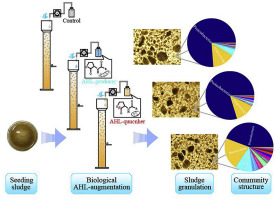当前位置:
X-MOL 学术
›
Water Res.
›
论文详情
Our official English website, www.x-mol.net, welcomes your feedback! (Note: you will need to create a separate account there.)
Augmentation of acyl homoserine lactones-producing and -quenching bacterium into activated sludge for its granulation
Water Research ( IF 12.8 ) Pub Date : 2017-08-29 , DOI: 10.1016/j.watres.2017.08.061 Yu-Sheng Li , Xin-Rong Pan , Jia-Shun Cao , Xiang-Ning Song , Fang Fang , Zhong-Hua Tong , Wen-Wei Li , Han-Qing Yu
Water Research ( IF 12.8 ) Pub Date : 2017-08-29 , DOI: 10.1016/j.watres.2017.08.061 Yu-Sheng Li , Xin-Rong Pan , Jia-Shun Cao , Xiang-Ning Song , Fang Fang , Zhong-Hua Tong , Wen-Wei Li , Han-Qing Yu

|
Quorum sensing (QS), especially acyl homoserine lactone (AHL)-mediated QS, in activated sludge arouses great interests because of its vital role in the formation of biofilm and aerobic granules (AG). Although QS is reported to be largely related to the properties of activated sludge, it is not economically feasible to tune QS in an activated sludge reactor through dosing pure AHL or AHL hydrolase. A more reasonable way to tune QS is to augment reactors with AHL-producing or -quenching bacteria. In this work, the impacts of continuous dose of AHL-producing or -quenching strains on the activated sludge during its granulation process were explored. Augmentation of AHL-producing or -quenching strains resulted in up- or down-regulation of the AHL concentration in the reactors. Granulation of activated sludge was also accomplished in all reactors, but the granules showed negligible or slight differences in the physicochemical properties of sludge, such as nutrients removal, biomass concentration, extracellular polymeric substances, and zeta potential. Interestingly, a smaller granule size was observed for both the reactor augmented with either an AHL-quenching strain or an AHL-producing strain, suggesting that the AHL augmentation suppressed the biofilm development. Pyrosequencing analysis reveals that the granules cultured in the reactors varied widely in bacterial community structure, indicating that the AHL augmentation had a greater impact on the bacterial community structure, rather than on the physicochemical properties of activated sludge. These results demonstrate that the role of QS in the biofilm formation in complex wastewater treatment bioreactors should be re-evaluated.
中文翻译:

将酰基高丝氨酸内酯生产和猝灭菌增强成活性污泥使其制粒
活化污泥中的群体感应(QS),尤其是酰基高丝氨酸内酯(AHL)介导的QS,引起了人们的极大兴趣,因为它在生物膜和好氧颗粒(AG)的形成中起着至关重要的作用。尽管据报道QS与活性污泥的性质有很大关系,但通过计量纯AHL或AHL水解酶来调节活性污泥反应器中的QS在经济上是不可行的。调整QS的一种更合理的方法是增加反应器中产生AHL或淬灭细菌的细菌。在这项工作中,探讨了连续剂量的AHL产生或淬灭菌株对活性污泥颗粒化过程的影响。AHL产生或淬灭菌株的增强导致反应器中AHL浓度的上调或下调。在所有反应器中还完成了活性污泥的制粒,但这些颗粒在污泥的理化特性(如营养去除率,生物量浓度,细胞外聚合物和zeta电位)上的变化可忽略不计或略有差异。有趣的是,对于用AHL猝灭菌株或产生AHL的菌株扩增的反应器,均观察到较小的颗粒尺寸,这表明AHL的扩增抑制了生物膜的发育。焦磷酸测序分析表明,反应器中培养的颗粒的细菌群落结构差异很大,这表明AHL的增加对细菌群落结构的影响更大,而不是对活性污泥的物理化学性质的影响更大。这些结果表明,应重新评估QS在复杂废水处理生物反应器中生物膜形成中的作用。
更新日期:2017-08-30
中文翻译:

将酰基高丝氨酸内酯生产和猝灭菌增强成活性污泥使其制粒
活化污泥中的群体感应(QS),尤其是酰基高丝氨酸内酯(AHL)介导的QS,引起了人们的极大兴趣,因为它在生物膜和好氧颗粒(AG)的形成中起着至关重要的作用。尽管据报道QS与活性污泥的性质有很大关系,但通过计量纯AHL或AHL水解酶来调节活性污泥反应器中的QS在经济上是不可行的。调整QS的一种更合理的方法是增加反应器中产生AHL或淬灭细菌的细菌。在这项工作中,探讨了连续剂量的AHL产生或淬灭菌株对活性污泥颗粒化过程的影响。AHL产生或淬灭菌株的增强导致反应器中AHL浓度的上调或下调。在所有反应器中还完成了活性污泥的制粒,但这些颗粒在污泥的理化特性(如营养去除率,生物量浓度,细胞外聚合物和zeta电位)上的变化可忽略不计或略有差异。有趣的是,对于用AHL猝灭菌株或产生AHL的菌株扩增的反应器,均观察到较小的颗粒尺寸,这表明AHL的扩增抑制了生物膜的发育。焦磷酸测序分析表明,反应器中培养的颗粒的细菌群落结构差异很大,这表明AHL的增加对细菌群落结构的影响更大,而不是对活性污泥的物理化学性质的影响更大。这些结果表明,应重新评估QS在复杂废水处理生物反应器中生物膜形成中的作用。


























 京公网安备 11010802027423号
京公网安备 11010802027423号